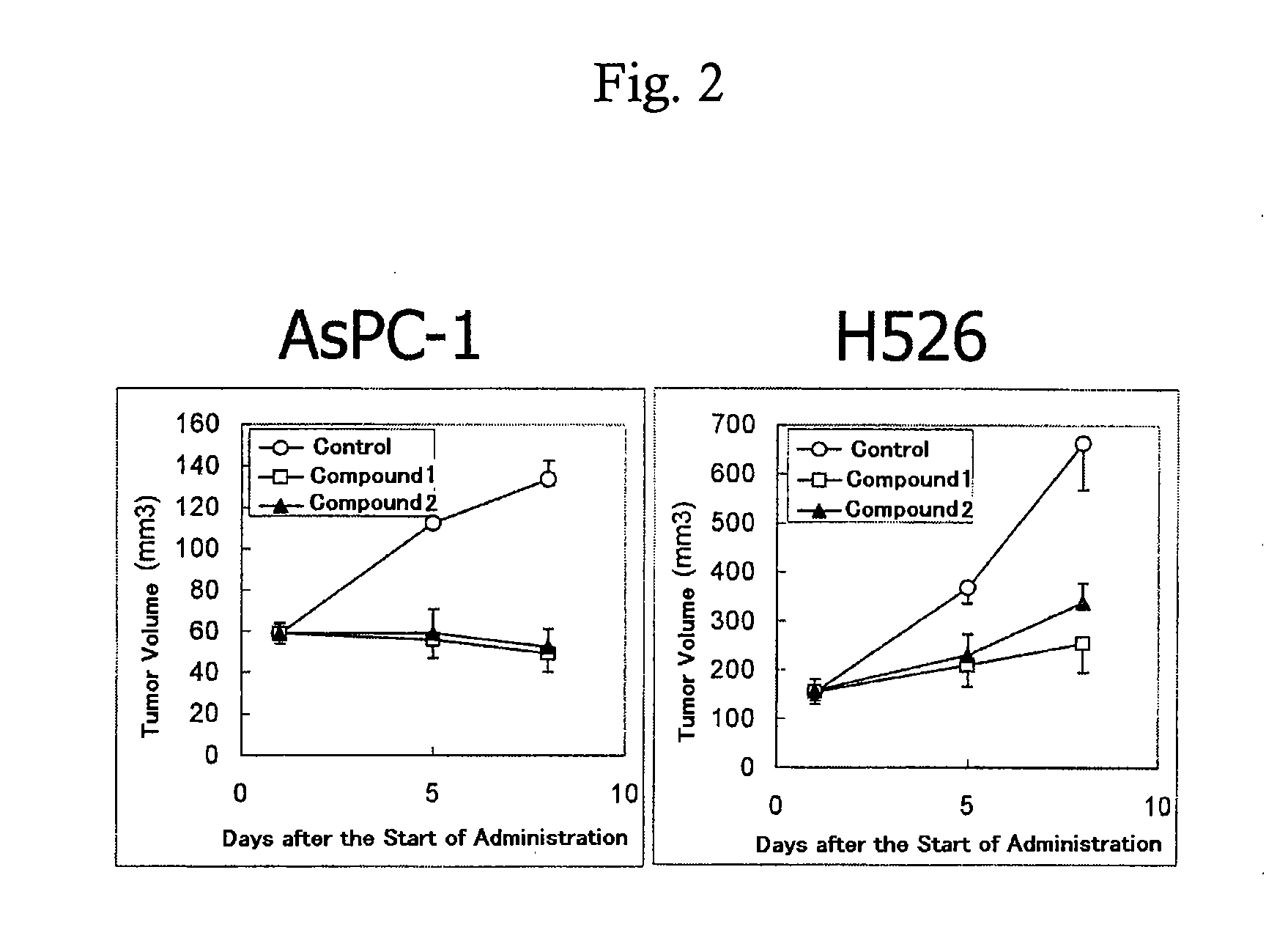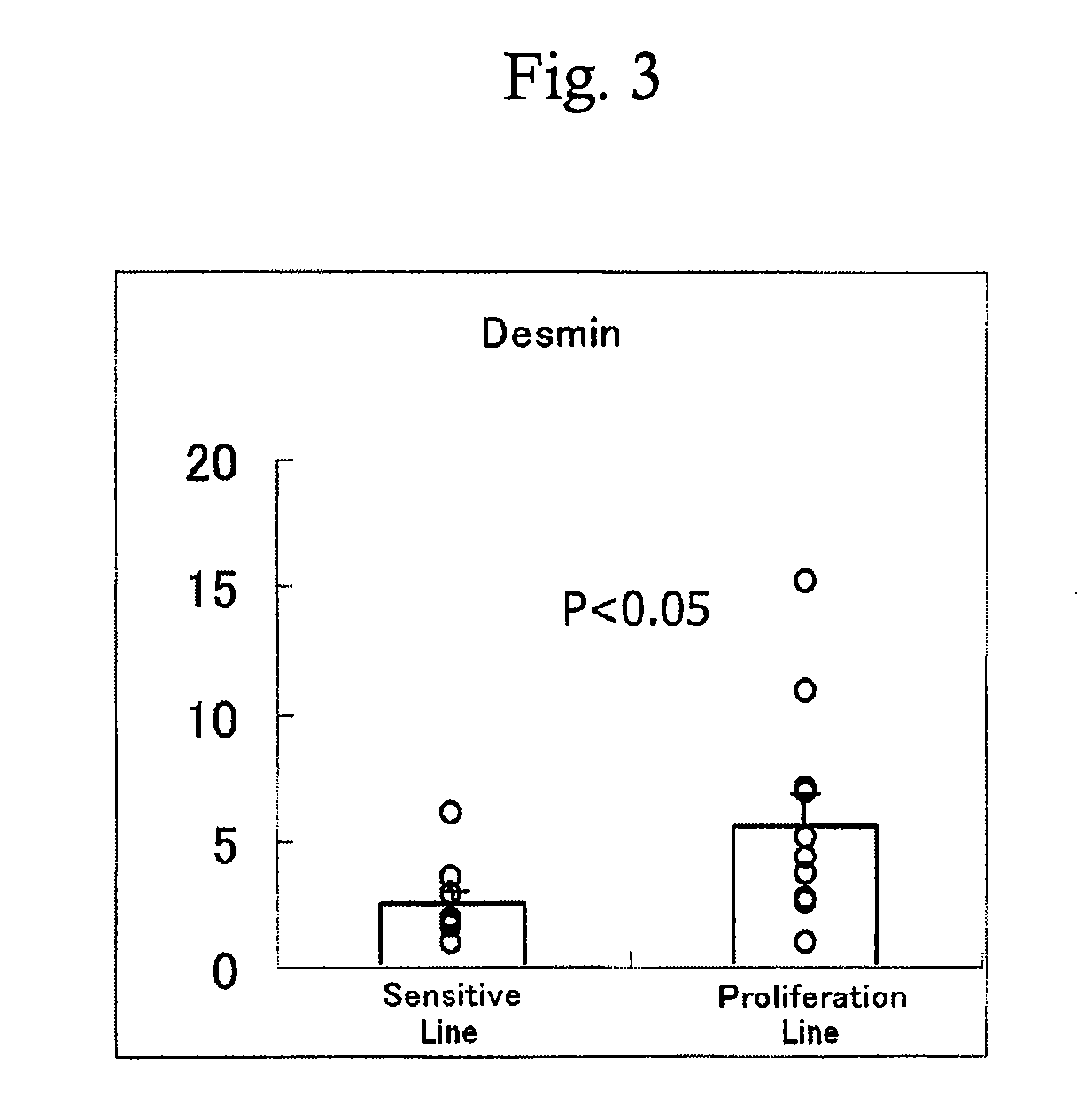Method for prediction of the efficacy of vascularization inhibitor
a technology of angiogenesis inhibitor and antitumor effect, which is applied in the field of can solve the problems that there is no effective method for predicting the effect of angiogenesis inhibitor prior to administration, and achieve the effect of predicting the antitumor effect of angiogenesis inhibitor and higher antitumor
- Summary
- Abstract
- Description
- Claims
- Application Information
AI Technical Summary
Benefits of technology
Problems solved by technology
Method used
Image
Examples
example 1
Anti-Tumor Effect of Angiogenesis Inhibitor in Human Cancer Cell Line Subcutaneously Transplanted Models (In Vivo)
[0374]Human cancer cell lines A375 (purchased from Dainippon Pharma Co., Ltd.), SEKI, HMV-1 (these two lines were purchased from JCRB cell bank, National Institute of Biomedical Innovation), FEM (granted from Dr. Fodstad, The Norwegian Radiumhospital Research Foundation), LOX (purchased from AntiCancer), AZ-521 (purchased from Japan Health Science Foundation), MDA-MB-468, DLD-1, HCT116, SW620, PC-3, DU145, AsPC-1, H526, MDA-MB-231, SK-Mel-2, Lovo and A431 (these 12 lines were purchased from ATCC) were cultured with RPMI1640 (containing 10% FBS) in a 5% CO2 incubator until they reached about 80% confluence. After culturing, cells from each line w ere recovered with trypsin-EDTA by conventional procedures. The cells were suspended in phosphate buffer solution to prepare a cell suspension of 1×108 cells / ml or 5×107 cells / ml. Subsequently, 0.1 ml of the cell suspension was s...
example 2
Preparation and Staining of Tumor Tissue Sections from Human Cancer Cell Line Subcutaneously Transplanted Models; and Correlation between the Antitumor Effect of Angiogenesis Inhibitor and the Ratio of the Number of Blood Vessels Covered with Pericytes to the Total Number of Blood Vessels
[0377]Human cancer cell lines A375 (purchased from Dainippon Pharma Co., Ltd.), SEKI, HMV-1 (these two strains were purchased from JCRB cell bank, National Institute of Biomedical Innovation), FEM (granted from Dr. Fodstad, The Norwegian Radiumhospital Research Foundation), LOX (purchased from AntiCancer), AZ-521 (purchased from Japan Health Science Foundation), MDA-MB-468, DLD-1, HCT116, SW620, PC-3, DU145, AsPC-1, H526, MDA-MB-231, SK-Mel-2, Lovo and A431 (these 12 strains were purchased from ATCC) were cultured with RPMI1640 (containing 10% FBS) in a 5% CO2 incubator until they reached about 80% confluence. After culturing, cells from each strain were recovered with trypsin-EDTA by conventional p...
example 3
Antitumor Effect of Angiogenesis Inhibitor in Human Cancer Cell Line Subcutaneously Transplanted Models (in vivo)
[0382]Human cancer cell lines AsPC-1 and H526 (both strains were purchased from ATCC) were cultured with RPMI1640 (containing 10% FBS) in a 5% CO2 incubator until they reached about 80% confluence. After culturing, cells from each strain were recovered with trypsin-EDTA by conventional procedures. The cells were suspended in phosphate buffer to prepare a cell suspension of 5×107 cells / ml. Subsequently, 0.1 ml of the cell suspension was subcutaneously transplanted on the lateral side of each nude mouse. After transplantation, when the tumor volume reached about 50-200 mm3, administration of 5-(5-fluoro-2-oxo-1,2-dihydroindole-3-ylidenemethyl)-2,4-dimethyl-1H-pyrrole-3-carboxylic acid (2-diethylaminoethyl)amide (100 mg / kg, once a day, one week, oral administration) was started. The 5-(5-fluoro-2-oxo-1,2-dihydroindole-3-ylidenemethyl)-2,4-dimethyl-1H-pyrrole-3-carboxylic aci...
PUM
| Property | Measurement | Unit |
|---|---|---|
| Ratio | aaaaa | aaaaa |
Abstract
Description
Claims
Application Information
 Login to View More
Login to View More - R&D
- Intellectual Property
- Life Sciences
- Materials
- Tech Scout
- Unparalleled Data Quality
- Higher Quality Content
- 60% Fewer Hallucinations
Browse by: Latest US Patents, China's latest patents, Technical Efficacy Thesaurus, Application Domain, Technology Topic, Popular Technical Reports.
© 2025 PatSnap. All rights reserved.Legal|Privacy policy|Modern Slavery Act Transparency Statement|Sitemap|About US| Contact US: help@patsnap.com



